|
HOME: www.hiltonpond.org |
|||
THIS WEEK at HILTON POND Subscribe for free to our award-winning nature newsletter (Back to Preceding Week; on to Next Week) |
|
All text, maps, charts & photos © Hilton Pond Center PICTURES DON'T LIE: A few years ago a benefactor gifted Hilton Pond Center with two infrared trail cameras we set up near the old farmhouse to keep an eye on night visitors at our bird feeding stations. Equipped with motion sensors, the cameras for the most part merely reinforced what we already suspected: White-tailed Deer were eating cracked and whole corn from the ground and Raccoons (above) sneaking under cover of darkness had learned to bypass baffles on our feeder poles and were consuming ample amounts of expensive black sunflower seeds.
All text, maps, charts & photos © Hilton Pond Center We documented several other mammals making nocturnal forays to the Center's feeders or merely passing through the property, including Eastern Cottontails (above), Striped Skunks, and even a fast-moving Gray Fox (below). The latter two we've seen only occasionally by day, so it was good to know they were still around after dark. Alas, there were also photos of wandering dogs (with collars, despite a county leash law!) and feral cats of several colors; their stealthy presence was not good news for wild fauna we try to protect at the Center.
All text, maps, charts & photos © Hilton Pond Center Occasionally a 'coon, 'possum, or one of those free-roaming felines is hit by a car on the paved road near our old farmhouse, in which case we usually scrape it up and haul it to a back corner of the property where nature can recycle. Such was the case in June 2016 when we to focused a trail cam on a succession of relocated roadkills. Image quality was not as good as we achieve with our dedicated Canon 70D body and professional lenses--after all, the real purpose of a trail cam is to document, not create art--but we still got interesting results and were even able to confirm a NEW mammalian species for Hilton Pond Center. (NOTE: All photos below were made with a Browning Dark Ops HD Camera.)
All text, maps, charts & photos © Hilton Pond Center Our Hilton Pond trail cams produce the most revealing photos after the sun goes down, but since they operate on a 24-hour basis we also capture lots of daytime images as birds and various critters pass through the field of view. Thus, we were not surprised when first visitors to a roadkill carcass were winged diurnal scavengers in the form of naked-headed Turkey Vultures (above)--although even THEY didn't show up immediately. The trail cam revealed nothing paid much attention to the roadkill for the first 36 hours--until it started giving off a little odor as Blow Flies and Carrion Beetles began their necessary but less-than-fastidious work. Turkey Vultures (known to birders as "TVs") are unusual among birds in having exceptionally sharp senses of smell and can detect the odor of decaying meat as they soar high overhead--even when a carcass is hidden by tree canopy. (NOTE: Recent research indicates birds in general may have better smelling ability than previously thought.) After circling and narrowing down the source of an odor, big TVs on their six-foot wingspans swoop in one by one and walk around the object of their interest, perhaps looking for a good angle of attack. Fairly quickly one of the TVs starts poking at the corpse with its moderately hooked bill, seldom using weak toes and talons except to stand on and keep the food source from slipping away. Eventually, the vulture breaks through the skin of the carcass and the feast begins.(NOTE: After losing some of our roadkills to scavengers who dragged them away from the trail cam, we began staking the carcasses with an iron rod; this also benefited hungry vultures by keeping their food immobile while they dined. The rod appears in some of our photos.)
All text, maps, charts & photos © Hilton Pond Center If several Turkey Vultures are present they often alternate pulling at the roadkill, sometimes cooperatively dismembering it by default. If a TV senses a competitor getting a bit too close, feeding territoriality may result with the two birds awkwardly gyrating, flapping wings, and lunging at each other with open bills. (NOTE: The photo above reveals this behavior and also shows the undersides of a Turkey Vulture's wings have pale trailing edges.)
All text, maps, charts & photos © Hilton Pond Center As the Turkey Vultures used sharp olfaction to beam in on our roadkill at Hilton Pond Center, vigilant Black Vultures were keeping a keen eye on the TVs. Often in the world of vulture competition a Turkey Vulture flock finds a dead animal, flies in to claim it, and then gets displaced by smaller but more aggressive Black Vultures (above). In the mid 1800s John James Audubon observed large numbers of Black Vultures--which he called "Carrion Crows"--walking pigeon-like around Lowcountry cities of Charleston and Savannah, where they booted out TVs and performed invaluable sanitation duties in an era when homeowners and shop owners simply dumped garbage on the curb. This scenario still plays out in some populated areas of Central and South America, where Black Vultures are quite numerous.
All text, maps, charts & photos © Hilton Pond Center After Turkey Vultures discovered one roadkill at the Center this June, they descended to begin feeding but were followed soon thereafter by several Black Vultures. In one case, a Black Vulture assumed an aggressive posture (above), spreading its wings and frustrating the hungry TV. This photo shows several other vulture characteristics worth mentioning: 1) The Black Vulture has white wingtips (unlike the Turkey Vulture's gray trailing edges mentioned earlier); 2) Black Vultures always have naked black heads with black, white-tipped bills while an adult TV's head is red with a red, white-tipped bill (head and bill are dark in juvenile TVs); 3) Although folks usually say Turkey Vultures are big black birds, their contour and flight feathers are actually brown, while the Black Vulture truly is black; and, 4) Turkey Vulture legs usually appear yellowish, while those of a Black Vulture are typically whitish--from the bird's habit of voiding uric acid onto its exposed toes and tibiotarsi. (NOTE: The function of this behavior is not well understood; it's possible deposits of white uric acid crystals reflect sunlight from legs that otherwise would absorb lots of solar heat. Or it may be that Black Vultures just have bad aim.)
All text, maps, charts & photos © Hilton Pond Center In our trail cam photo above, the Turkey Vulture at foreground walks off with a measly strip of non-nutritious sinew and another looks on as two Black Vultures dominate the carcass and pick at what's left of the good stuff. The TVs' featherless heads and red facial skin are quite apparent, as are pale edgings on their wing coverts.
All text, maps, charts & photos © Hilton Pond Center Thanks to the work of these two vulture species at the Center, nothing remained of the road kill except skin, bones, and fur (above). With the corpse dry and winged scavengers gone, other animals wandered down the perimeter path past the trail cam. Among the most commonly photographed creatures both day and night were White-tailed Deer, in this case a doe with her newborn spotted fawn (above). The curious youngster momentarily sniffed at the carcass but soon moved on to mother's milk.
All text, maps, charts & photos © Hilton Pond Center Another white-tailed doe that wandered by Hilton Pond Center appeared to have suffered serious consequences after birthing her fawn(s). Note the large pink structure on her rump in the photo above. Our diagnosis of this abnormality was confirmed by newly graduated veterinarian Rebecca E. Pollard: A prolapsed uterus that everted as the fawn was expelled from the birth canal. Dr. Pollard postulated this doe--already thin--was not likely to survive much longer in such serious condition. It wasn't a very pleasant thing to see but demonstrates how a trail cam can provide wildlife information that otherwise might go undetected.
All text, maps, charts & photos © Hilton Pond Center The motion detector in our trail cam is surprisingly sensitive, occasionally being triggered by a falling leaf or moth flitting past. Even small diurnal mammals such as Eastern Gray Squirrels (above) can take a "selfie" while probing the pine needles for nuts and pine seeds. (NOTE: 2016 apparently has been a very good year for squirrels at Hilton Pond Center . We have many more than in recent memory. The young ones are busy learning how to custom-build trampolines and extension ladders to reach our "squirrel-proof" feeders.)
All text, maps, charts & photos © Hilton Pond Center We certainly can't be everywhere during the day at Hilton Pond Center , so our trail cams can indeed reveal much about what's happening on outlying sections of the 11-acre property. When the cameras really pay off, however, is after sunset when human eyes are poorly adapted to see who's roaming about. As noted, White-tailed Deer (above) are moving day and night, their eyes glowing demon-like in the dark when an infrared flash goes off.
All text, maps, charts & photos © Hilton Pond Center Raccoons (above) also showed up often in recent trail cam exposures at the Center. Interestingly, these masked marauders seldom paid attention to road kills we staked out--maybe because they had already filled their bellies with the Center's cornucopia of gourmet sunflower seeds.
All text, maps, charts & photos © Hilton Pond Center Virginia Opossums will eat 'most anything, so we weren't surprised to see a photo of one (above) sniffing through what the vultures had left behind. In all, the trail cam detected at least four different 'possums at various road kills in June--probably (if local road-killed 'possums themselves are any indicator) just a fraction of the population at Hilton Pond Center.
All text, maps, charts & photos © Hilton Pond Center We were pleased to find the trail cam on a couple of occasions snapped fleeting photos of Gray Foxes at the roadkill. Through the years we have observed both Gray Foxes and Red Foxes at the Center, the former being far more common. (NOTE: A Red Fox would have a prominent white tail tip and black feet, which is how we knew this was a Gray Fox in the photo.) Numbers of both fox species have diminished around Hilton Pond in the past decade or so--likely because of increased numbers of Coyotes engaged in fox-hunting on surrounding farms. (NOTE: Coyotes are big wild dogs that apparently like to eat foxes, which are smaller wild dogs. Coyotes like any small dog, for that matter, which is good reason not to let your Pomeranian out after dark if Coyotes are in the neighborhood. Coyotes apparently like to eat cats, too.)
All text, maps, charts & photos © Hilton Pond Center We were indeed happy to document that Gray Fox, but very displeased to see the above trail cam image of a large pale-colored feral tomcat stalking around the Center at night. These free-roaming predators kill everything they encounter either for food or for sport, from nestling birds to small mammals to ever-declining frogs and toads. Apparently our succulent roadkill was not fresh enough for this cat; several photos showed him sniffing but never tasting the carcass. Here's hoping he was moving on to somewhere else.
All text, maps, charts & photos © Hilton Pond Center Finally in June the roadkill trail cam snapped a photo of an animal we had been trying to document all along; one night a healthy male Coyote came in to examine the carcass and triggered the image above. About two decades ago, we stood on the back deck at Hilton Pond Center after dark and for the first time heard the hair-raising sound of a Coyote family singing. In years since the local Coyote population has increased significantly; most nights we can hear three different family groups howling at the moon--or in harmony with fire sirens. Despite this eerie chorus we had never actually seen an elusive Coyote on the property and might never hope to; nonetheless, the trail cam image above allows us at long last to add Coyote to the Center's natural history inventory as Mammal Species #29.
All text, maps, charts & photos © Hilton Pond Center A few nights after the trail cam snapped its first Coyote picture at Hilton Pond Center, a second individual (above) happened by and was photographed scent-marking the area where the roadkill had been. This Coyote had much lighter built and carried a less-bushy tail; we're by no means experts on this native species, but we suspect it was a young female.
All text, maps, charts & photos © Hilton Pond Center The third week in June after we conclusively documented Coyotes with the trail cam, we were quite surprised to get a day-time image of a mature Wild Turkey hen strutting through the field of view. We had no turkeys at the Center in the early 1980s when the land was mostly grass and shrubs, but by the late 1990s these big birds became more numerous as old fields turned to open mixed woodland. About then our first Coyotes arrived and for ten years or so we've seen no turkeys nor heard any gobbling--not even picked up any iridescent turkey feathers along the trails--and we figured they had been pretty much wiped out. Evidence from the trail cam shows at least one Wild Turkey is still around, as are foxes we thought had more or less disappeared from the Center thanks to Coyotes. One pair of diurnal human eyes can see only so much, while several strategically placed cameras--in tandem with reasonably fresh road kills--can reveal there's much more going on at Hilton Pond Center than might be suspected. After all, trail cam pictures do not lie. All text, maps, charts & photos © Hilton Pond Center
Checks can be sent to Hilton Pond Center at: All contributions are tax-deductible on your |
|---|
|
"This Week at Hilton Pond" is written and photographed by Bill Hilton Jr., executive director of Hilton Pond Center for Piedmont Natural History
|
|
|
Please refer "This Week at Hilton Pond" to others by clicking on this button: |
Comments or questions about this week's installment? Send an E-mail to INFO. (Be sure to scroll down for a tally of birds banded/recaptured during the period, plus other nature notes.) |

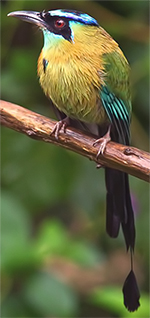 WHEN IT'S DREARY AND COLD
WHEN IT'S DREARY AND COLD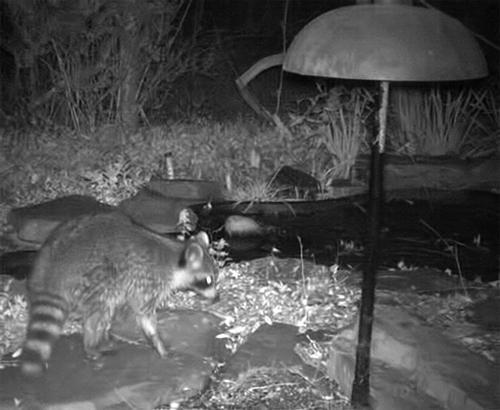
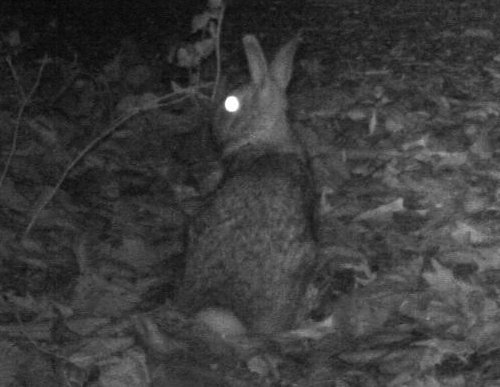
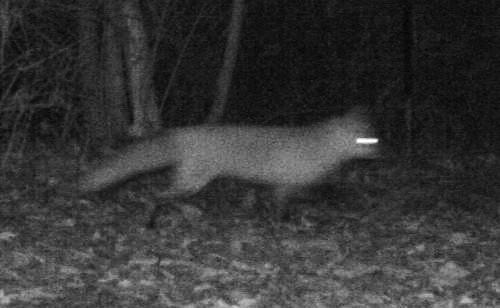
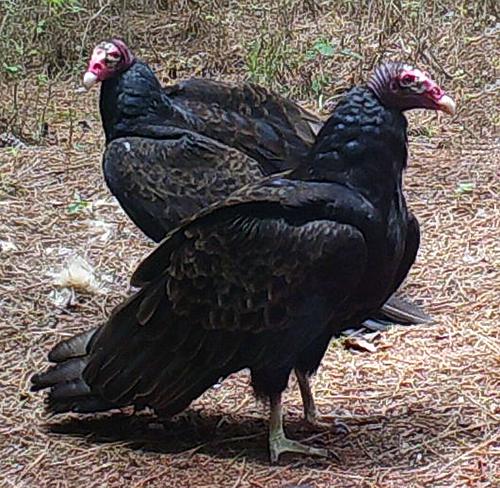
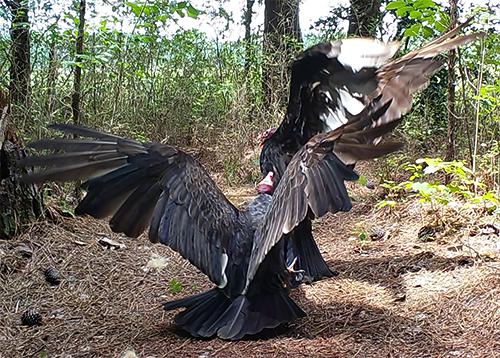

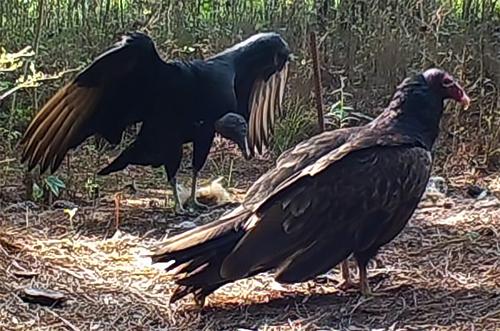

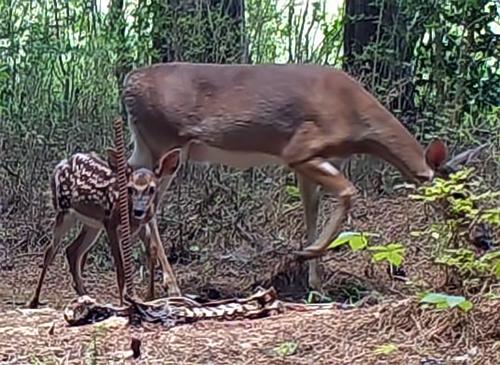
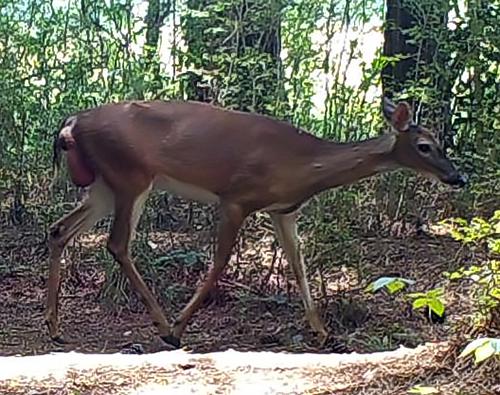

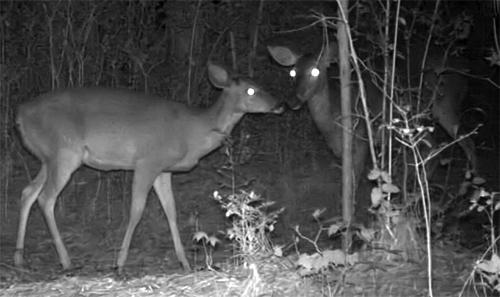
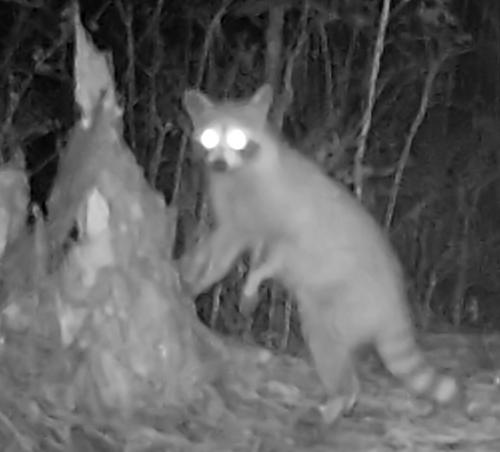

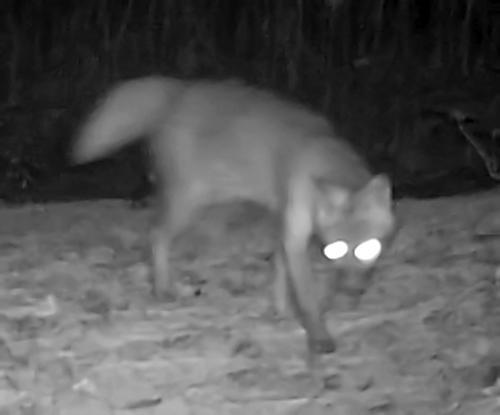
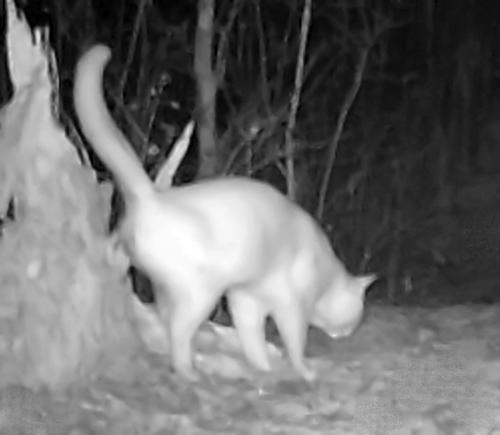
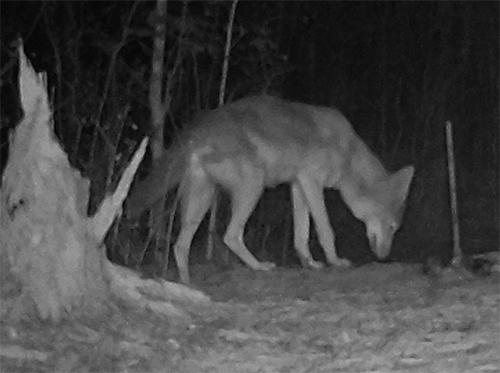

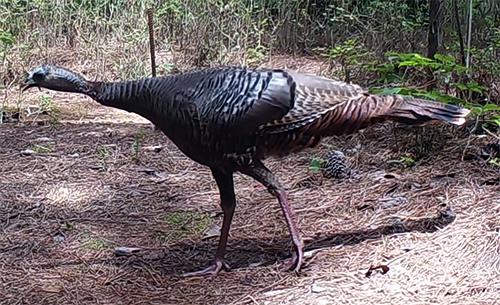









 Please report your spring, summer &
Please report your spring, summer &